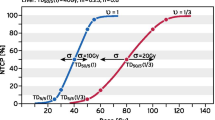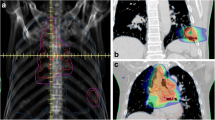Background:
Stereotactic irradiation of extracranial targets offers a non-invasive treatment modality for patients with localized tumors, which are not amenable for surgery or other invasive approaches because of age or impaired medical condition. The purpose of the study was the evaluation of the method to achieve local control of irradiated targets in relation to treatment toxicity.
Patients and Methods: Irradiation was performed as hyperfractionated treatment in three fractions of 10 Gy each, normalized to the PTV enclosing 65% isodose with patient fixation in a stereotactic body frame. The isocenter was localized by stereotactic coordinates. Targets were circumscribed tumors in the lung (n = 27) and liver (n = 24) not amenable for other treatment modalities: primary lung cancer (n = 12), local recurrences of lung cancer (n = 4), lung metastases (n = 11), liver metastases (n = 23) and one cholangiocellular carcinoma. Median CTV/PTV for targets in the lung was 57/113 cm3 (min/max 5–277 cm3/17–343 cm3) and for targets in the liver 50/102 cm3 (min/max 9–516 cm3/42–772 cm3). Median follow-up for targets in the lung was 8 months (2–33) and 9 months (2–28) for liver targets. Local control was defined as complete or partial remission and stable disease, measured by repeated CT scans after 6 weeks and in 3 months intervals. Treatment toxicity was evaluated according to the WHO score.
Results: Crude local control was 85% for pulmonary targets and 83% for hepatic targets. Actuarial local control after 1 and 2 years was 76% and 76% for lung tumors and 76% and 61% for liver tumors. Actuarial overall patient survival was 48% after 1 year and 21% after 2 years for targets in the lung and 71% and 43% for targets in the liver. No acute grade 3–5 side effects were observed. Serious late toxicity occurred in two patients: a chronic ulceration of the esophagus at a target close to the mediastinum after 3 months (grade 3) and fatal bleeding from the pulmonary artery after 9 months (grade 5) in a previously irradiated patient. It remained unclear, whether the bleeding was a side effect of irradiation or due to tumor infiltration.
Conclusion: Hypofractionated stereotactic irradiation of targets in the lung and liver is a locally effective treatment with actuarial local control rates of 76% after 1 year and 61–76% after 2 years without relevant acute toxicity. Severe late toxicity did not occur, if targets close to the mediastinum were avoided.
Hintergrund:
Prüfung eines hypofraktionierten, stereotaktischen Behandlungsansatzes für Bestrahlung lokalisierter Raumforderungen in der Lunge und Leber hinsichtlich lokaler Tumorkontrolle und Nebenwirkungen.
Patienten und Methode: Stereotaktische Bestrahlung in drei Fraktionen à 10 Gy, normalisiert auf die PTV-umschließende 65%-Isodose mit Patientenfixierung im stereotaktischen Körperrahmen. Insgesamt wurden 27 Lungentumoren (zwölf primäre und vier lokoregionär rezidivierte Bronchialkarzinome, elf Metastasen) und 24 Lebertumoren (23 Metastasen, ein cholangiozelluläres Karzinom) behandelt. Das CTV/PTV für Lungenherde betrug im Median 57/113 cm3 (min/max 5–277 cm3/17–343 cm3), für Leberherde 50/102 cm3 (min/max 9–516 cm3/42–772 cm3). Die mediane Nachbeobachtungszeit betrug 8 Monate (2–33) für Lungen- und 9 Monate (2–28) für Leberherde. Lokale Kontrolle wurde definiert als computertomographisch komplette oder partielle Remission sowie Wachstumsstopp 6 Wochen sowie in Intervallen von 3 Monaten nach Therapie. Die Nebenwirkungen wurden nach WHO klassifiziert.
Ergebnis: Lokale Kontrolle betrug numerisch in der Lunge 85%, in der Leber 83%, aktuarisch in der Lunge 76% nach 1 und 2 Jahren, in der Leber 76% nach 1 Jahr, 61% nach 2 Jahren. Das aktuarische Gesamtüberleben lag nach 1 und 2 Jahren bei Lungenherden bei 48% und 21% bzw. bei Leberherden bei 71% und 43%. Akut traten keine Nebenwirkungen Grad 3–5 auf. Als Spätnebenwirkung wurden eine chronische Ösophagitis (Grad 3) bei einem dicht am Mediastinum gelegenen Tumor sowie eine fatale Blutung aus der Arteria pulmonalis beobachtet, bei der jedoch auch eine tumorbedingte Arrosionsblutung nicht auszuschließen war.
Schlussfolgerung: Die stereotaktische Bestrahlung von Lungen- und Leberherden ist eine effektive Bestrahlungsform mit aktuarischen lokalen Kontrollraten bis zu 76% nach 1 Jahr bzw. 61–76% nach 2 Jahren. Die Akuttoxizität war gering; schwere Spätnebenwirkungen traten nicht auf, wenn Zielvolumina in der Nähe des Mediastinums vermieden wurden.
Similar content being viewed by others
Author information
Authors and Affiliations
Additional information
Received: July 5, 2001; accepted: August 22, 2001
Rights and permissions
About this article
Cite this article
Wulf, J., Hädinger, U., Oppitz, U. et al. Stereotactic Radiotherapy of Targets in the Lung and Liver. Strahlenther Onkol 177, 645–655 (2001). https://doi.org/10.1007/PL00002379
Issue Date:
DOI: https://doi.org/10.1007/PL00002379




